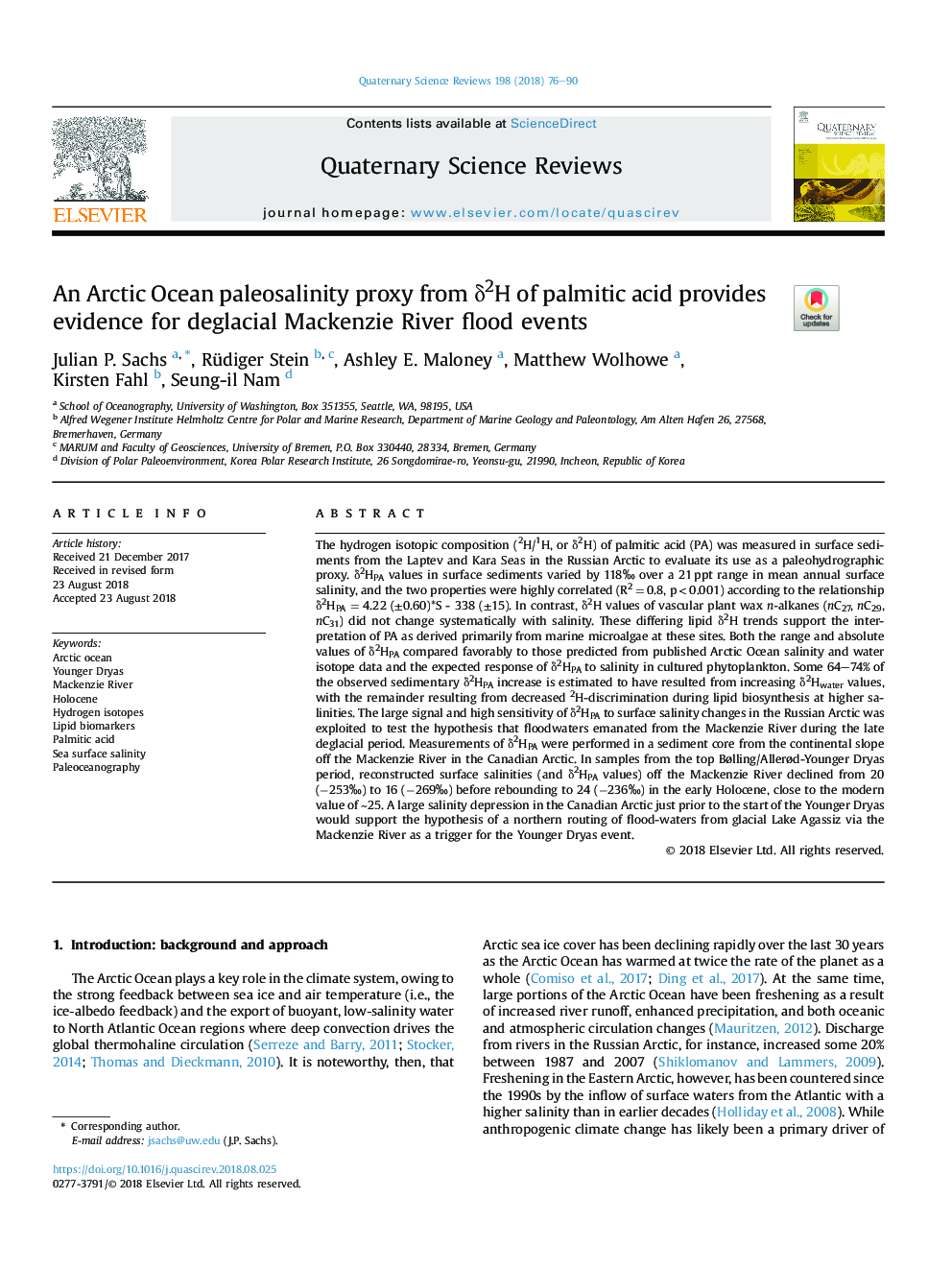| کد مقاله | کد نشریه | سال انتشار | مقاله انگلیسی | نسخه تمام متن |
|---|---|---|---|---|
| 8966187 | 1646784 | 2018 | 15 صفحه PDF | دانلود رایگان |
عنوان انگلیسی مقاله ISI
An Arctic Ocean paleosalinity proxy from δ2H of palmitic acid provides evidence for deglacial Mackenzie River flood events
دانلود مقاله + سفارش ترجمه
دانلود مقاله ISI انگلیسی
رایگان برای ایرانیان
کلمات کلیدی
Arctic Ocean - اقیانوس منجمد شمالی یا اقیانوس آرکتیکHydrogen isotopes - ایزوتوپهای هیدروژنLipid biomarkers - بیومارکرهای لیپیدیPaleoceanography - دیرینه اقیانوس شناسیMackenzie River - رود مکنزیSea surface salinity - شوری سطح آبHolocene - هولوسنPalmitic acid - پالمیتیک اسیدYounger Dryas - یانگر درایاس، داغگلی نورس
موضوعات مرتبط
مهندسی و علوم پایه
علوم زمین و سیارات
زمین شناسی
پیش نمایش صفحه اول مقاله

چکیده انگلیسی
The hydrogen isotopic composition (2H/1H, or δ2H) of palmitic acid (PA) was measured in surface sediments from the Laptev and Kara Seas in the Russian Arctic to evaluate its use as a paleohydrographic proxy. δ2HPA values in surface sediments varied by 118â° over a 21â¯ppt range in mean annual surface salinity, and the two properties were highly correlated (R2â¯=â¯0.8, pâ¯<â¯0.001) according to the relationship δ2HPA = 4.22 (±0.60)*S - 338 (±15). In contrast, δ2H values of vascular plant wax n-alkanes (nC27, nC29, nC31) did not change systematically with salinity. These differing lipid δ2H trends support the interpretation of PA as derived primarily from marine microalgae at these sites. Both the range and absolute values of δ2HPA compared favorably to those predicted from published Arctic Ocean salinity and water isotope data and the expected response of δ2HPA to salinity in cultured phytoplankton. Some 64-74% of the observed sedimentary δ2HPA increase is estimated to have resulted from increasing δ2Hwater values, with the remainder resulting from decreased 2H-discrimination during lipid biosynthesis at higher salinities. The large signal and high sensitivity of δ2HPA to surface salinity changes in the Russian Arctic was exploited to test the hypothesis that floodwaters emanated from the Mackenzie River during the late deglacial period. Measurements of δ2HPA were performed in a sediment core from the continental slope off the Mackenzie River in the Canadian Arctic. In samples from the top Bølling/Allerød-Younger Dryas period, reconstructed surface salinities (and δ2HPA values) off the Mackenzie River declined from 20 (â253â°) to 16 (â269â°) before rebounding to 24 (â236â°) in the early Holocene, close to the modern value of â¼25. A large salinity depression in the Canadian Arctic just prior to the start of the Younger Dryas would support the hypothesis of a northern routing of flood-waters from glacial Lake Agassiz via the Mackenzie River as a trigger for the Younger Dryas event.
ناشر
Database: Elsevier - ScienceDirect (ساینس دایرکت)
Journal: Quaternary Science Reviews - Volume 198, 15 October 2018, Pages 76-90
Journal: Quaternary Science Reviews - Volume 198, 15 October 2018, Pages 76-90
نویسندگان
Julian P. Sachs, Rüdiger Stein, Ashley E. Maloney, Matthew Wolhowe, Kirsten Fahl, Seung-il Nam,